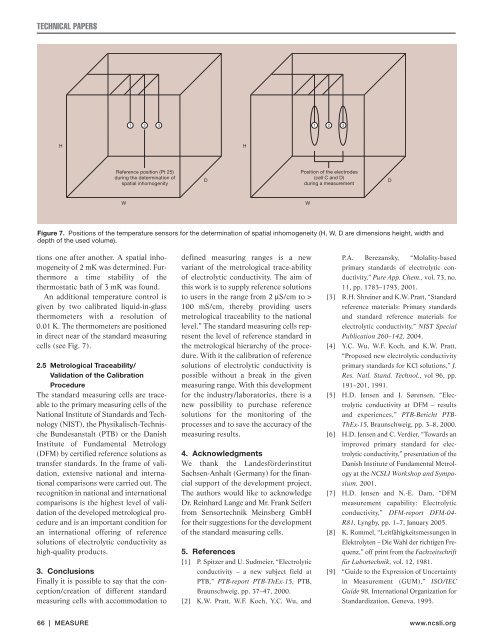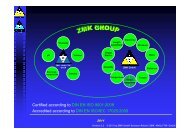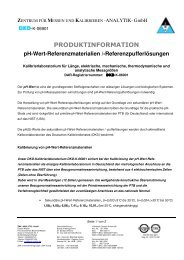Experiences with Novel Secondary Conductivity Sensors within the ...
Experiences with Novel Secondary Conductivity Sensors within the ...
Experiences with Novel Secondary Conductivity Sensors within the ...
You also want an ePaper? Increase the reach of your titles
YUMPU automatically turns print PDFs into web optimized ePapers that Google loves.
TECHNICAL PAPERS<br />
H<br />
Reference position (Pt 25)<br />
during <strong>the</strong> determination of<br />
spatial inhomogenity<br />
tions one after ano<strong>the</strong>r. A spatial inhomogeneity<br />
of 2 mK was determined. Fur<strong>the</strong>rmore<br />
a time stability of <strong>the</strong><br />
<strong>the</strong>rmostatic bath of 3 mK was found.<br />
An additional temperature control is<br />
given by two calibrated liquid-in-glass<br />
<strong>the</strong>rmometers <strong>with</strong> a resolution of<br />
0.01 K. The <strong>the</strong>rmometers are positioned<br />
in direct near of <strong>the</strong> standard measuring<br />
cells (see Fig. 7).<br />
2.5 Metrological Traceability/<br />
Validation of <strong>the</strong> Calibration<br />
Procedure<br />
The standard measuring cells are traceable<br />
to <strong>the</strong> primary measuring cells of <strong>the</strong><br />
National Institute of Standards and Technology<br />
(NIST), <strong>the</strong> Physikalisch-Technische<br />
Bundesanstalt (PTB) or <strong>the</strong> Danish<br />
Institute of Fundamental Metrology<br />
(DFM) by certified reference solutions as<br />
transfer standards. In <strong>the</strong> frame of validation,<br />
extensive national and international<br />
comparisons were carried out. The<br />
recognition in national and international<br />
comparisons is <strong>the</strong> highest level of validation<br />
of <strong>the</strong> developed metrological procedure<br />
and is an important condition for<br />
an international offering of reference<br />
solutions of electrolytic conductivity as<br />
high-quality products.<br />
3. Conclusions<br />
Finally it is possible to say that <strong>the</strong> conception/creation<br />
of different standard<br />
measuring cells <strong>with</strong> accommodation to<br />
W<br />
1 2 3 1 2 3<br />
D<br />
Figure 7. Positions of <strong>the</strong> temperature sensors for <strong>the</strong> determination of spatial inhomogeneity (H, W, D are dimensions height, width and<br />
depth of <strong>the</strong> used volume).<br />
H<br />
defined measuring ranges is a new<br />
variant of <strong>the</strong> metrological trace-ability<br />
of electrolytic conductivity. The aim of<br />
this work is to supply reference solutions<br />
to users in <strong>the</strong> range from 2 µS/cm to ><br />
100 mS/cm, <strong>the</strong>reby providing users<br />
metrological traceability to <strong>the</strong> national<br />
level.” The standard measuring cells represent<br />
<strong>the</strong> level of reference standard in<br />
<strong>the</strong> metrological hierarchy of <strong>the</strong> procedure.<br />
With it <strong>the</strong> calibration of reference<br />
solutions of electrolytic conductivity is<br />
possible <strong>with</strong>out a break in <strong>the</strong> given<br />
measuring range. With this development<br />
for <strong>the</strong> industry/laboratories, <strong>the</strong>re is a<br />
new possibility to purchase reference<br />
solutions for <strong>the</strong> monitoring of <strong>the</strong><br />
processes and to save <strong>the</strong> accuracy of <strong>the</strong><br />
measuring results.<br />
4. Acknowledgments<br />
We thank <strong>the</strong> Landesförderinstitut<br />
Sachsen-Anhalt (Germany) for <strong>the</strong> financial<br />
support of <strong>the</strong> development project.<br />
The authors would like to acknowledge<br />
Dr. Reinhard Lange and Mr. Frank Seifert<br />
from Sensortechnik Meinsberg GmbH<br />
for <strong>the</strong>ir suggestions for <strong>the</strong> development<br />
of <strong>the</strong> standard measuring cells.<br />
5. References<br />
[1] P. Spitzer and U. Sudmeier, “Electrolytic<br />
conductivity – a new subject field at<br />
PTB,” PTB-report PTB-ThEx-15, PTB,<br />
Braunschweig, pp. 37–47, 2000.<br />
[2] K.W. Pratt, W.F. Koch, Y.C. Wu, and<br />
Position of <strong>the</strong> electrodes<br />
(cell C and D)<br />
during a measurement<br />
P.A. Berezansky, “Molality-based<br />
[3]<br />
primary standards of electrolytic conductivity,”<br />
Pure App. Chem., vol. 73, no.<br />
11, pp. 1783–1793, 2001.<br />
R.H. Shreiner and K.W. Pratt, “Standard<br />
reference materials: Primary standards<br />
and standard reference materials for<br />
electrolytic conductivity,” NIST Special<br />
Publication 260–142, 2004.<br />
[4] Y.C. Wu, W.F. Koch, and K.W. Pratt,<br />
“Proposed new electrolytic conductivity<br />
primary standards for KCl solutions,” J.<br />
Res. Natl. Stand. Technol., vol 96, pp.<br />
191–201, 1991.<br />
[5] H.D. Jensen and J. Sørensen, “Electrolytic<br />
conductivity at DFM – results<br />
and experiences,” PTB-Bericht PTB-<br />
ThEx-15, Braunschweig, pp. 3–8, 2000.<br />
[6] H.D. Jensen and C. Verdier, “Towards an<br />
improved primary standard for electrolytic<br />
conductivity,” presentation of <strong>the</strong><br />
Danish Institute of Fundamental Metrology<br />
at <strong>the</strong> NCSLI Workshop and Symposium,<br />
2001.<br />
[7] H.D. Jensen and N.-E. Dam, “DFM<br />
measurement capability: Electrolytic<br />
conductivity,” DFM-report DFM-04-<br />
[8]<br />
R81, Lyngby, pp. 1–7, January 2005.<br />
K. Rommel, “Leitfähigkeitsmessungen in<br />
Elektrolyten – Die Wahl der richtigen Frequenz,”<br />
off print from <strong>the</strong> Fachzeitschrift<br />
für Labortechnik, vol. 12, 1981.<br />
[9] “Guide to <strong>the</strong> Expression of Uncertainty<br />
in Measurement (GUM),” ISO/IEC<br />
Guide 98, International Organization for<br />
Standardization, Geneva, 1995.<br />
66 | MEASURE www.ncsli.org<br />
W<br />
D






